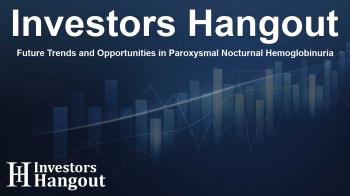Future Trends and Opportunities in Paroxysmal Nocturnal Hemoglobinuria

Introduction to the Paroxysmal Nocturnal Hemoglobinuria Market
The Paroxysmal Nocturnal Hemoglobinuria (PNH) market is currently experiencing a surge due to rising awareness about the disease and advancements in treatment methodologies. More specifically, the availability of targeted therapies has significantly shifted the treatment paradigm. Complement inhibitors, such as eculizumab and ravulizumab, represent groundbreaking treatments that have changed patient outcomes dramatically in this space.
Growth Factors in the PNH Market
The market for paroxysmal nocturnal hemoglobinuria is projected to grow robustly, influenced by various factors. Increased awareness among healthcare professionals and patients about this rare disease is pivotal in driving market growth. Enhanced diagnostics and the adherence to innovative therapies have resulted in improved patient outcomes.
Emerging Therapies and Pipeline Candidates
Several promising drugs are in the pipeline that could further contribute to market growth. Candidates such as Pozelimab (REGN3918) combined with Cemdisiran, Zaltenibart, and Ruxoprubart are garnering attention and are expected to play significant roles in future treatment landscapes. These therapies focus on various mechanisms of action, aiming to enhance the effectiveness of existing treatments.
Market Analysis
Given the increasing prevalence of PNH, the market size is estimated at approximately USD 1.3 billion in 2024 across the seven major markets (7MM), which includes the United States, the EU4, the United Kingdom, and Japan. The United States commands a substantial share, contributing roughly 85% of the total market size.
Current Treatments and Their Impact
Current therapeutic modalities primarily revolve around C5 complement inhibitors like eculizumab (Soliris) and ravulizumab (Ultomiris). These drugs have demonstrated significant efficacy in managing the disease, representing a major advancement in treatment outcomes for patients. The extended half-life formulations of these therapies enhance patient convenience and adherence to treatment.
New Treatment Developments
The advent of novel therapies such as pegcetacoplan (Empaveli), a complement C3 inhibitor, marks another critical milestone in PNH treatment. It provides an opportunity to address unmet needs in patients who may not respond to C5 inhibitors effectively. Additionally, new therapies like iptacopan provide oral administration options, broadening therapeutic avenues for patients and clinicians alike.
The Evolving Landscape of PNH Management
As the landscape for PNH management evolves, the focus is shifting towards precision medicine tailored to individual patient profiles. This approach not only includes pharmacological interventions but also involves comprehensive patient management strategies focusing on quality of life and long-term health outcomes. The emphasis on personalized treatment is likely to drive demand for novel drugs and management practices.
Challenges in the PNH Market
Despite the positive trends in PNH treatment, challenges remain. Ongoing hemolysis in some patients despite treatment, chronic anemia, and fatigue impact the overall quality of life. Furthermore, limitations in physician awareness of PNH's varied symptoms can lead to delays in diagnosis, which negatively affects patient outcomes. A concerted effort towards educational initiatives for both healthcare professionals and patients is necessary to mitigate these challenges.
Regulatory Developments and Investment Trends
Regulatory bodies are also adapting to the changing dynamics of PNH treatment, with new drugs undergoing rigorous review processes. The potential approval of novel agents will likely attract significant investment from pharmaceutical companies and stimulate competition within the market, ultimately benefiting patients through greater access to effective therapies.
Conclusion
The future of the paroxysmal nocturnal hemoglobinuria market is promising. With ongoing research, advancements in treatment options, and increased disease awareness, the landscape is set to transform. Emerging therapies, alongside established treatment modalities, hold the potential to improve patient outcomes and significantly impact the overall structure of the PNH market in the years to come.
Frequently Asked Questions
What is Paroxysmal Nocturnal Hemoglobinuria?
Paroxysmal Nocturnal Hemoglobinuria (PNH) is a rare, acquired blood disorder that leads to the destruction of red blood cells. It originates from mutations in the PIG-A gene in hematopoietic stem cells.
What treatments are currently available for PNH?
Current treatments include complement inhibitors like eculizumab and ravulizumab, which target specific pathways in the complement system to prevent the destruction of red blood cells.
What are the emerging therapies for PNH?
Emerging therapies include Pozelimab, Zaltenibart, and Ruxoprubart, which are under development and aim to provide targeted treatment options for patients with PNH.
How does awareness affect the diagnosis of PNH?
Increased awareness among healthcare professionals and patients can lead to earlier diagnosis and treatment, significantly improving patient outcomes.
What are the key drivers of growth in the PNH market?
Key drivers include advancements in treatment options, increased disease awareness, and evolving therapeutic landscapes that focus on patient-centered approaches.
About The Author
Contact Thomas Cooper privately here. Or send an email with ATTN: Thomas Cooper as the subject to contact@investorshangout.com.
About Investors Hangout
Investors Hangout is a leading online stock forum for financial discussion and learning, offering a wide range of free tools and resources. It draws in traders of all levels, who exchange market knowledge, investigate trading tactics, and keep an eye on industry developments in real time. Featuring financial articles, stock message boards, quotes, charts, company profiles, and live news updates. Through cooperative learning and a wealth of informational resources, it helps users from novices creating their first portfolios to experts honing their techniques. Join Investors Hangout today: https://investorshangout.com/
The content of this article is based on factual, publicly available information and does not represent legal, financial, or investment advice. Investors Hangout does not offer financial advice, and the author is not a licensed financial advisor. Consult a qualified advisor before making any financial or investment decisions based on this article. This article should not be considered advice to purchase, sell, or hold any securities or other investments. If any of the material provided here is inaccurate, please contact us for corrections.

